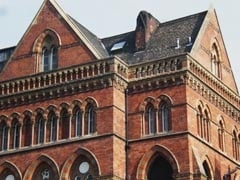Now that the Victorian Gothic of George Gilbert Scott’s Leeds General Infirmary (generally known as the LGI) has started to be revealed in all its glory by cleaning and restoration work carried out by York and Manchester based building conservation specialists William Anelay, it is clear that what initially appears to be a brick building actually incorporates a lot of stone.
Where replacements stone was needed, Anelay, whose Small Works Department were main contractors for the project, used Hillhouse Edge sandstone from George Graham & Son’s quarry at Holmfirth.
The first two phases of the work have been completed with two more phases to go, and David Marsh, Head of Small Works at William Anelay, says the plan has been constantly adapted and updated almost on a daily basis as the work has revealed new areas of concern.
Apart from Anelay’s stonemasons restoring much of damaged sandstone masonry and sculptures that adorn virtually every face and corner of the building, and the marble pillars, they have also tied the masonry together using cementitious sock anchors throughout the fascia.
Dave Marsh explains: “This approach involves drilling small deep holes through adjoining affected areas and then filling them with consolidation anchors that are filled with cementitious grout with the infill entry points then made good.
“It’s a highly adaptable and very reliable system that is employed on many structurally damaged buildings. It will keep the LGI flagship building standing strong for generations to come.”
A number of chimneys and tall ironwork finials that were listing heavily and required urgent attention have also been repaired and Anelay’s leadworkers have been busy repairing the roof.
And if you think the picture of the LGI below looks familiar, it is perhaps not surprising as it was opened in 1868, the same year as St Pancras railway station at the front of which is another of Scott’s Gothic masterpieces, the Midland Hotel, to which the LGI bears some remarkable similarities.

